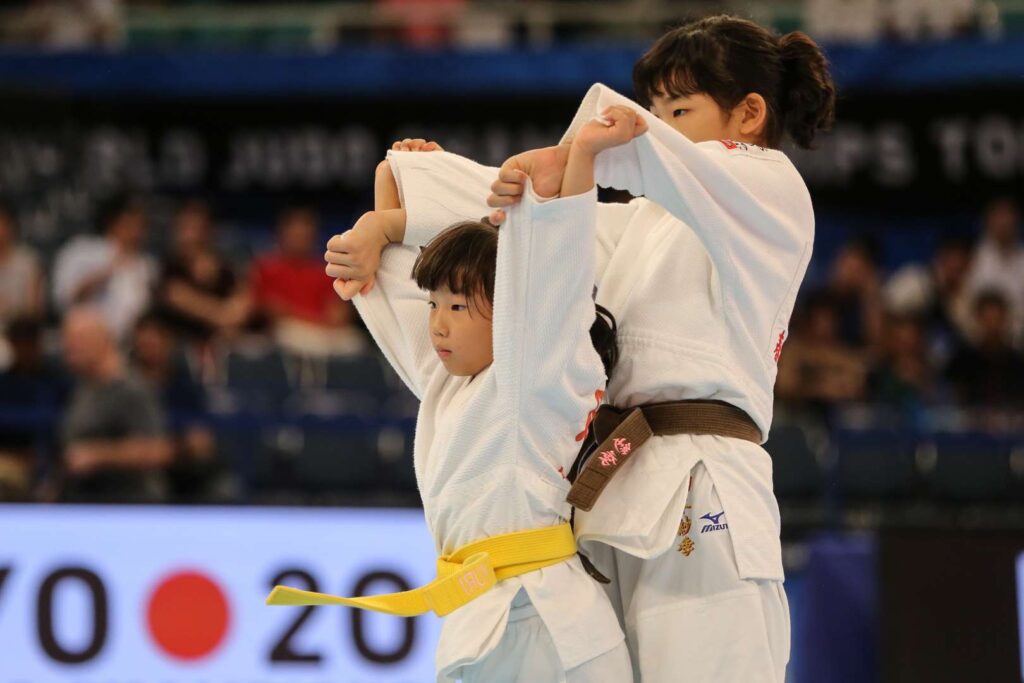Kodomo-no-Kata – The Children’s Kata
The Japanese word kodomo translates to children. The Kodomo-no-Kata is specifically designed for young judoka, with the aim of helping them understand the essential principles of judo through structured practice.
Kodomo-no-Kata consists of seven distinct units, each of which can be practiced and taught independently. Together, these units form a progressive pathway toward safely approaching the fundamentals of judo. Each unit includes elements of falling (ukemi), body movement (tai-sabaki), throwing techniques (nage-waza), and hold-downs (osaekomi-waza).
The primary objective of this kata is to provide an educational tool for club instructors. It encompasses not only the basics of safe judo practice, but also technical knowledge that can serve as criteria for rank advancement. Kodomo-no-Kata can also be performed as a demonstration, helping to develop memory, discipline, and an appreciation for the aesthetic and technical beauty of judo.
Kodomo-no-Kata 1 (ichi)
- 1. Ritsu-rei and Za-rei
- 2. Mae-mawari-ukemi
- 3. Uchi-mata 4. Harai-goshi
- 5. Ko-uchi-gari→ Ippon-seoi-nage
- 6.Ippon-seoi-nage→ Kesa-gatame→ Ushiro-kesa-gatame →Yoko-shihogatame→Kamishiho-gatame
- 7. Za-rei and Ritsu-rei
Kodomo-no-Kata 2 (ni)
- 1. Ritsu-rei and Za-rei
- 2. Mae-ukemi
- 3. Mae-mawari-ukemi
- 4. O-uchi-gari
- 5. Ko-uchi-gari
- 6. O-soto-gari
- 7. O-uchi-gari→Kouchi-gari
- 8. O-soto-gari→Yokoshiho-gatame→ Tate-shiho-gatame →Kata-gatame
- 9. Za-rei and Ritsu-rei
Kodomo-no-Kata 3 (san)
- 1. Ritsu-rei and Za-rei
- 2. Mae-ukemi
- 3. Mae-mawari-ukemi
- 4. Tai-sabaki
- 5. Kuzushi with moving
- 6. Sasae-tsurikomiashi
- 7. Ippon-seoi-nage
- 8. Tsurikomi-goshi
- 9. Sasae-tsurikomiashi→Kesa-gatame
- 10. Za-rei and Ritsu-rei
Kodomo-no-Kata 4 (yon)
- 1. Ritsu-rei and Za-rei
- 2. Ushiro-ukemi
- 3. Yoko-ukemi
- 4. Mae-mawari-ukemi
- 5. Tai-sabaki
- 6. Happo-no-kuzushi with moving
- 7. Hiza-guruma
- 8. Tai-otoshi
- 9. O-goshi
- 10. Za-rei and Ritsu-rei
Kodomo-no-Kata 5 (go)
- 1. Ritsu-rei and Za-rei
- 2. Ushiro-ukemi
- 3. Yoko-ukemi
- 4. Mae-mawari-ukemi
- 5. Happo-no-kuzushi
- 6. De-ashi-harai
- 7. Uki-otoshi
- 8. Uki-goshi
- 9. Za-rei and Ritsu-rei
Kodomo-no-Kata 6 (roku)
- 1. Ritsu-rei and Za-rei
- 2. Ushiro-ukemi
- 3. Yoko-ukemi
- 4. Outen-ukemi
- 5. Tai-sabaki
- 6. Ayumi-ashi
- 7. Tsugi-ashi
- 8. Hiza-guruma
- 9. Tai-otoshi
- 10. Za-rei and Ritsu-rei
Kodomo-no-Kata 7 (nana)
- 1. Ritsu-rei and Za-rei
- 2. Ushiro-ukemi
- 3. Yoko-ukemi
- 4. Outen-ukemi
- 5. Tai-sabaki
- 6. Ayumi-ashi
- 7. Tsugi-ashi
- 8. Throwing by Mae-sabaki
- 9. Throwing by Ushiro-sabaki
- 10. Za-rei and Ritsu-rei
